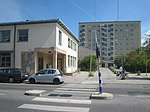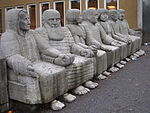Hägersten-Liljeholmen

Hägersten-Liljeholmen is a borough (stadsdelsområde) in Stockholm, Sweden. It is part of the Söderort suburban area. The borough is located in South Stockholm. The districts that make up the borough are Aspudden, Fruängen, Gröndal, Hägersten, Hägerstensåsen, Liljeholmen, Midsommarkransen, Mälarhöjden, Västberga, and Västertorp. The population of Hägersten-Liljeholmen borough is 83,283 as of 2014. The borough was formed on January 1, 2007 by merging the Hägersten borough (Hägersten, Fruängen, Hägerstensåsen, Mälarhöjden and Västertorp) with Liljeholmen borough (Aspudden, Gröndal, Midsommarkransen, Västberga and a portion of Hägersten).
Excerpt from the Wikipedia article Hägersten-Liljeholmen (License: CC BY-SA 3.0, Authors, Images).Hägersten-Liljeholmen
Bokbindarvägen, Stockholm Hägerstensåsen (Hägersten-Älvsjö stadsdelsområde)
Geographical coordinates (GPS) Address Nearby Places Show on map
Geographical coordinates (GPS)
| Latitude | Longitude |
|---|---|
| N 59.301944444444 ° | E 17.987777777778 ° |
Address
Bokbindarvägen 31
129 33 Stockholm, Hägerstensåsen (Hägersten-Älvsjö stadsdelsområde)
Sweden
Open on Google Maps







